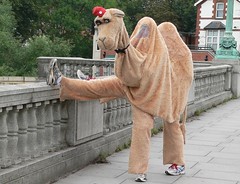 What is involved in the stretching regimen that was used in the recent USATF study?
What is involved in the stretching regimen that was used in the recent USATF study?
There were 3 different stretches that they used (technically 4 since the last stretch had 2 parts.) The subjects that were going to be stretching were supplied with a detailed stretch protocol that included the photographs of the stretch, as well as images of what they were supposed to be doing.
This video demonstrates how to do the full stretching regimen:
(Download This Video)
Quadriceps
 The first stretch was a quadriceps stretch. From a standing position you need to grasp your foot or ankle on the same sided leg, and then pull your foot gently up towards your butt.
The first stretch was a quadriceps stretch. From a standing position you need to grasp your foot or ankle on the same sided leg, and then pull your foot gently up towards your butt.
You steady yourself with the opposite hand, and then you can lean back to increase the stretch if you want to. Without bouncing, hold that stretch for about 10 seconds and repeat 3 times for each leg.
Hamstring
 The second stretch was for your hamstrings. From a standing position, place the leg to stretch somewhere that you can elevate your leg.
The second stretch was for your hamstrings. From a standing position, place the leg to stretch somewhere that you can elevate your leg.
Lean forward over your thigh and try to reach your foot. Again, without bouncing you want to hold that stretch for about 10 seconds and then repeat 3 times for each leg.
Calf/Achilles
 The third stretch was for your calf and achilles. From a standing position, you want to lean forward with the leg to be stretched straight out behind you, foot flat on the ground.
The third stretch was for your calf and achilles. From a standing position, you want to lean forward with the leg to be stretched straight out behind you, foot flat on the ground.
Keep your knee near straight for a full 10 seconds, and then flex the knee and repeat the stretch with the knee bent for 10 seconds. Again, there should be no bouncing and you want to repeat that 3 times for each leg.
(Better) Quadriceps
 If you want to do this routine yourself, I would make one small change with the quadriceps stretch. Instead of using the same arm as the leg that you’re stretching, I would actually use the opposite arm.
If you want to do this routine yourself, I would make one small change with the quadriceps stretch. Instead of using the same arm as the leg that you’re stretching, I would actually use the opposite arm.
For your right leg you would want to stretch your leg using your left arm, and for your left leg you would want to stretch it with your right arm.
The reason for that is that it puts a lot less stress on your knee because it’s a much more natural movement for your knee to be going across your body a little bit instead of having it come straight up in towards the outside. You are much less likely to strain your knee to a point where you might get hurt.
Of course, if you aren’t currently stretching before your runs, you may not want to start stretching. The results of the USATF study seem to find that for people that aren’t currently stretching, a pre-run stretch isn’t likely to improve your ability to avoid injuries.
(Stretching Study: USATF & Run to Win – Photo Credits: Humphrey the Camel & Blaine Moore)
Recent Comments: